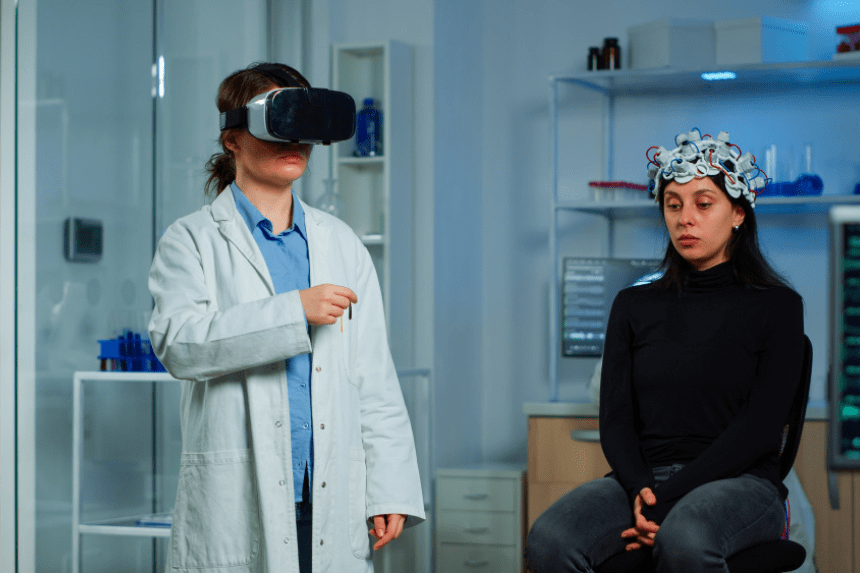Modern healthcare technology is transforming doctor training and patient care. AR and VR are leading this shift. Immersive and interactive experiences improve patient outcomes and medical education. VR and AR are improving the healthcare industry by combining academic and practical knowledge. They simulate real-life scenarios and provide detailed pictures.
Virtual reality improves medical training.
VR technology improves medical training by giving students and workers a safe space to experiment and improve. Cadavers and mannequins are employed in medical education, although they’re not human bodies. VR solves these issues with realistic, interactive 3D human body representations. Medical students can zoom in on organs, tissues, and systems in these models to understand the body.
Medical students can practice clinical and surgical skills in VR simulations without harming patients. These simulations can help learners gain confidence and skills from easy to complex and rare circumstances. Osso VR provides realistic surgical simulators for clinicians to rehearse before performing on actual patients. This practical knowledge shortens the learning curve and improves healthcare practitioners.
AR in medical education
Augmented reality also improves medical education by integrating digital information into the environment. Learning becomes more engaging and hands-on. AR allows medical professionals and students to see complex bodily parts on actual or computer-generated models. This talent enhances spatial awareness and helps children understand complicated subtleties that pictures and writing cannot convey.
Medical schools educate anatomy and surgery via apps like Microsoft’s HoloLens. The HoloLens allows individuals to see and interact with 3D body part holograms, improving body comprehension. AR can also assist surgeons in locating blood arteries and cancers by superimposing them on the patient’s body. Real-time guidance can improve precision and reduce errors.
Improving patient care via virtual reality
Virtual reality also changes patient care by offering novel diagnosis and treatment methods. VR can treat chronic pain and anxiety sufferers by creating immersive situations that distract them. VR has been demonstrated to reduce pain and anxiety, making it a beneficial complement to pain care.
VR treatment may aid PTSD, phobias, and depression. By creating controlled virtual environments, therapists can gradually help patients face their anxieties and painful memories. Through exposure therapy, people learn to manage their emotions, improving their mental health.
Problem diagnosis is also more straightforward with VR. In three dimensions, VR imaging shows complex medical data, such as MRI and CT scans. It helps doctors comprehend a patient’s condition and find better treatments. VR gives doctors more detailed and realistic graphics to help them make better decisions and treat patients.
Medical augmented reality
AR provides real-time guidance to doctors and nurses throughout procedures, revolutionizing clinical practice. Surgery is one of AR’s main medical applications. AR can show surgeons anatomical markers and surgical pathways. Real-time guiding can improve accuracy and reduce errors in intricate and minimally invasive procedures.
On the Augmedics xvision AR platform, doctors may visualize a patient’s spine in 3D while operating. This device gives surgeons real-time input and helps them move and work more correctly. Interventional radiology uses AR to guide catheters and other equipment through blood arteries, improving therapeutic safety and efficacy.
AR goes beyond surgery. Patients are consulted and taught there. Doctors can use AR to show patients body components and processes to explain their illnesses and treatment strategies. This participatory strategy helps patients comprehend and participate, improving their treatment choices and adherence.
Wrapping up
VR and AR are altering medicine by redefining doctor training and patient care. Medical students and personnel learn better by practicing skills and procedures in safe VR simulations. AR adds digital information to the physical environment, improving medical education. Students learn anatomy and clinical guidelines.
VR helps patients cope with pain, stress, and mental health issues and improves diagnosis and treatment. AR provides clinicians with real-time instructions and information during treatments, improving accuracy and reducing risks. As these technologies improve, using them in healthcare will make it better and faster, improving patient outcomes and changing medicine.






